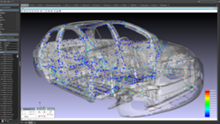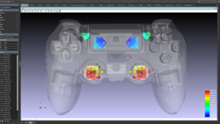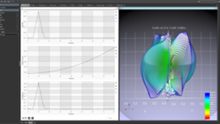CAEfatigue premium package
Advanced Random Analysis Output
For many automotive and aerospace systems it is required to calculate both durability and to rule out the possibility of collision of individual components during severe base shake vibration conditions. Advanced frequency domain methods now exist to enable the durability assessment and response to be assessed in the same analysis. With the advanced random analysis output, it is possible to output displacement and/or velocity and/or acceleration and/or force RMS levels and Power Spectral Density (PSD) plots for both absolute and relative responses. In addition, a residual sum of the squares (RSS) is calculated to take into account any off axis response. New post processing options allow the relative response from any node to be compared against the actual distance to all nearby nodes in order to check for the probability of collisions (i.e. RATTLE) between adjacent parts. The response maximum is determined using either a ratio of the RMS (e.g. 3.0*rms) from a corresponding level of probability on a Gaussian or Rayleigh distribution, or by using a method which takes into account the number of cycles of response. Advanced Random Analysis output is an excellent addition to predict structural response under complicated loading conditions found in many engineering applications throughout a wide variety of industries.Calculation of SURROGATE Loading
The specification of loads for durability is a very important topic. Ideally, any loads used in an analysis or in a laboratory-based test procedure, should be as close as possible to the Customers use of the product. In practice, the nearest scenario that can be achieved is to measure multi events and multi-input loads (with correlation) from prototype vehicles (test tracks) and then replay these in the laboratory or analysis environment. For analysis, this is feasible and is a commonly adopted method although it does not easily deal with the topic of test acceleration. For laboratory-based simulation, especially of parts or subsystems, there is a need (usually because of available test equipment) to simplify the loads down to single input load applied one at a time (e.g. X, then Y, then Z), which poses significant challenges. Two common approaches are currently used. First, an enveloping procedure can be applied to the loads where the multiple loads are combined into a single smoothed profile. A classical application of this procedure involves no knowledge of the structural system so there is no assurance that the enveloped loads will cause the same damage values or distribution. Second, is to use the concept of a Fatigue Damage Spectrum (FDS) where a simplified loading is created which does the same damage on a hypothetical 1 DOF system (where the resonance is moved through the loading). Again, this takes no account of the actual structural system or systems. Surrogate Loading provides a NEW approach, which is a variation of the FDS approach but using the actual system properties. The Surrogate Loading tool provides a way to transform a complicated multi-channel, multi-event time history loading into a simplified “SURROGATE LOAD” that will provide a very similar stress and damage output for the system as the complex test time history did.Calculations at Welds in the Frequency and Time Domains
CAEfatigue has created an industry first! We now provide the ability to conduct a full Spot Weld, Seam Weld and User Defined weld analysis in the Frequency Domain along with the more traditional methods used in the Time Domain. This capability will allow a full automotive vehicle analysis, that includes spot and seam welds, to be conducted with CF in either the Frequency domain or Time domain.
-
Collateral










